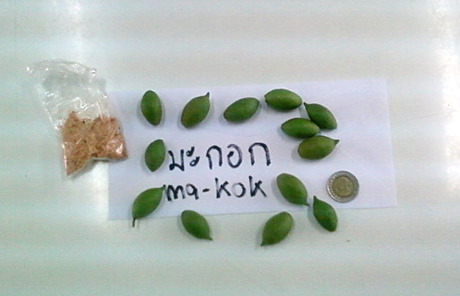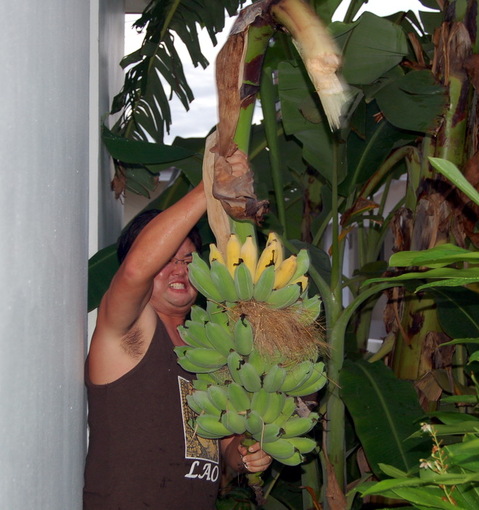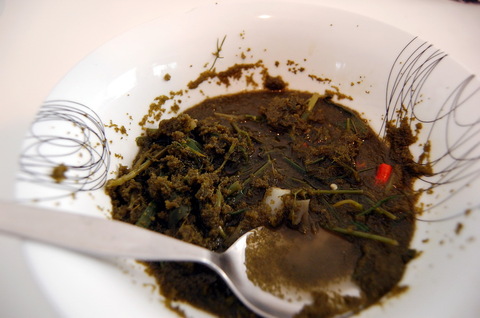
In Japanese, this specific position might be called a reverse inari-otoshi (falling inari). If you’ve ever seen an inarizushi up close, you may understand why. It’s usually performed on an unsuspecting high school friend who is sleeping face-up, and does not make you automatically hated among your peers, however disturbing the imagery might be (this is all hearsay; I didn’t even go to high school in Nippon).
Say it three times with me: Inariotoshi, inari-otoshi, ??????
That is your cultural baggage of the day; some things cannot be un-read.
(image from Cyanide and Happiness via Adam)
Category: Food
Spotted Richard
It seems the Welsh have submitted fully to their nanny state and its uber-PC agenda. I present to you the faded glory of Spotted Dick with its newly government-approved nomenclature: Pudding renamed Spotted Richard
Today suet pudding, tomorrow your right to breathe, I tell you.
They should have tried a compromise. You know, something a with a bit more pizazz. How about Speckled Prick or Dotted Cock?
What they settled on for an alternative, Sultana Sponge, is kinda more disgusting in a contraceptical kinda way, if you know what I mean… A bit of Sultana Sponge with heavy cream, anyone?
And how about renaming their town while they’re at it?
Spondias mombin aka ma-kok (?????)

Somebody brought in a bag of these the other day and I’d never seen them before so I had somebody write down the name. If I’m summarizing correctly, this may be a kind of olive, or related to olives. What I know is that it was really bitter and sour, the taste of bitter fruits that make your mouth pucker or what the Japanese call shibui (astringent). That explains the bag of chili-laced sugar the ma-kok are sold with (although this also accompanies sweet fruits as well; pineapples, sour mango, various indigenous “apples,” etc.)
I have to be careful to record all of the rare stuff I encounter here because I may never see some of them again.
Saccharomyces Draught
Over at Wired: Brewing Beer From 45-Million-Year-Old Yeast
Unspeakably cool.
In most of Asia, they’d probably still drink it with ice, tho.
smell my armpit
I forgot to post my instructional photo on how to harvest bananas, caveman style:

Unable to hold the clump with one hand while chopping with the other (the clump was hanging over into the neighbor’s yard in an awkward position – don’t worry they got their cut!), I instead used E. Honda power to rip it off.
This was taken a couple months ago in our backyard. We pretty much have the best tasting bananas in the world, and they are the perfect food for babies. We even sun-dried some and made chips. Yum!
P.S. That’s an empty bird’s nest constructed in between the fruit. We’d spotted it before but never saw what kind of birds made it – I made sure it was vacant before starting the harvest.
P.P.S. After harvesting bananas you cut down the tree (actually a “pseudostem”) because it only bears fruit once. Ours get quite thick by the time the fruit is ripe, around the diameter of a basketball, or larger at the base.
P.P.P.S. I bought this bad ass thick brush knife, about 18″ long, maybe carved from a leaf spring. It’s fun as hell to concentrate and try cutting down banana trees with one stroke, although it’s kinda cramped in our backyard so I have to be really careful not to cut my own leg or get crushed by a vengeful felled pseudostem.
The Story of Sriracha
Sriracha sauce that is: A Chili Sauce to Crow About
My parents had a bottle of Sriracha on the table ever since I was about ten, so I literally grew up with it. Last year when a university van drove us back home from Pattaya through the actual town of Sriracha, I was all jazzed about buying local sauces there, but that wasn’t their specialty – their specialty was marble mortar and pestles, and we did buy a good set of those.
The equivalent chili sauces in Thailand are horridly sweet except for a few brands, which are decent but not nearly as good as Sriracha. When you go to a noodle stand in Thailand, you are presented with a plethora of flavorings to add, such as fish sauce, dried chili, wet chili paste, Sriracha-like sauce, vinegar (or vinegar-infused chili), sugar, ground peanuts, thai lime, etc., so it’s not such a huge deal for noodles, but Sriracha is sorely missed for other foods. You end up substituting things like prik-nampla-manao (literally, chili-fishsauce-lime), but just end up wishing SE Asians would just realize how damn good Sriracha is and just import it by the boatload from the US of A. Kind of like a reverse (culinary) FOB type thing I guess.
////////////////////////////////////
All I can say is – Sriracha should have “Tran 84” on the bottles.
taco bell folk song
Is it me or do they sound a bit like the D?
Pond Scum Soup
On Sunday we went to an outdoor market in a park downtown where many fresh produce vendors gather. It’s an excellent place to find strange new (to me anyway) fruits and veggies, and sometimes even plants for our garden. This day proved to be no exception and we found a lady selling what looked like Japanese aojiru powder (green juice powder made from barley and other healthy crap) from a bucket. Upon closer inspection the granules were too large to be aojiru and were also quite damp. The old lady didn’t really explain what it was that well to Nam, so we had our nanny go ask. Nanny already knew what it was and said she could prepare a soup with it, so I of course bought some, about a pound, for 15 Baht (45 cents).
It turned out to be some kind of vegetation that grows on the surface of a pond, or as I like to call it, pond scum.
The soup she made was quite good; it smelled pleasant and tasted hearty with a hint of lemongrass, and the texture of the scum was like miniature flying fish roe, or soft grains of sand. Nanny said it would have been better if she’d had pork belly to add to it, but really, what food couldn’t benefit from some pork belly?
Cake Wreck
This is perhaps my favorite entry on the whole Cake Wrecks blog:



